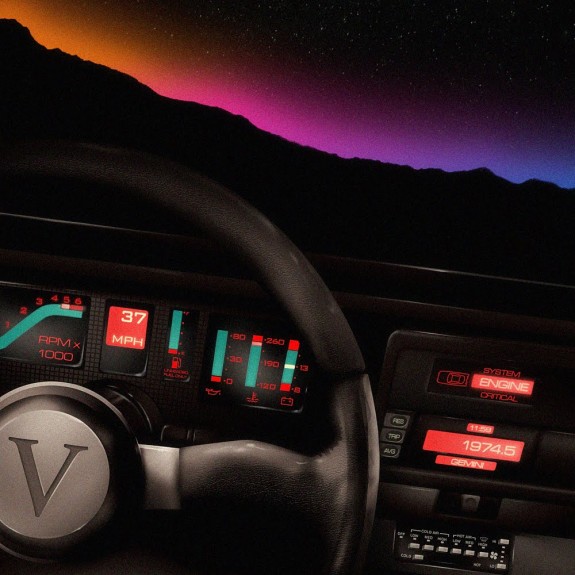Film soundtracks are a notoriously hard sell outside of their film context. 2011 saw a minor trend in affixing popular music artists to celluloid, resulting in the misplaced fervor and expectation that surrounded Daft Punk’s score for Tron: Legacy as the French house duo’s fourth official album. It wasn’t, which shouldn’t have been a surprise to anyone, but the soundtrack in question is a perfect portrait of where film scores and fully-formed records can often go their separate ways. Devoid of its film’s hard glossy blacks and primary colored neon, Daft Punk’s bombastic orchestra-laden, synth-heavy score seemed to be making a big stink about nothing in particular. That lack of substantive heft that made songs feel disjointed and too economic, well, that’s where the film fit. Alternately, Symmetry’s Themes for an Imaginary Film works two-fold; a collection of tracks meant to invoke subtle atmospheric and emotional color, and a cohesive, stand-alone document that does much to paint its theoretical film along the listener’s imagination.
Conflicting reports of Italians Do It Better and Symmetry head Johnny Jewel’s initial involvement in the score for Nicolas Winding Refn’s 2011 minimalist crime noir, Drive, have been pervasive enough to nearly swallow the project whole upon its arrival. Themes for an Imaginary Film is not the lost, original soundtrack to Drive, but Jewel was indeed approached to do the music for the aforementioned film and his Symmetry project is derived from the work meant for its score. While Jewel asserts none of the original material written for Drive has made it onto Themes, the record still shares some direct and specific similarities made evident by its cover depicting a car’s glossy dashboard and console speeding toward the atomic haze of a Los Angeles sunset. However, Jewel’s longtime disco and synth pop work with Chromatics and Glass Candy, along with Italians Do It Better’s aesthetic at large, originally served as his calling card for Drive‘s producers – specifically Chromatic’s Night Drive – and it’s just as easy to make an argument that Jewel’s own work (and Symmetry and Chromatic collaborator Nat Walker’s) was as instrumental in informing Drive‘s striking inclusion of dusky electro pop music to add color and revelry to its dark and brooding tone (Chromatics’ own “Tick of the Clock” or Desire’s “Under Your Spell,” which both made it onto the Drive OST, for instance).
Jewel himself has spoken to the extent to which Night Drive influenced Themes for an Imaginary Film, going so far as calling it “a more ambient or sound-designed extension” in a recent interview with Pitchfork. It describes the sounds and instrumentation found on Themes well – trudging 4/4 analog thump, plucky guitars, and icy Italo synths thrumming with the arpeggiated tension of a Goblin tune. Night Drive already had some cinematic aspirations setting its twilit tone with a cast-off recording of two lovers making late night plans over a phone call before the protagonist sets off through a humid night behind a sticky leather steering wheel. The atmosphere found on Themes is very similar – if not a bit more sonorous and less wind-in-your-hair breezy with the addition of strings, darker synth textures, and stern pianos – and just as devoted to that timeless refuge found behind the wheel beneath a blanket of stars.
Themes For an Imaginary Film‘s lasting triumph is its ability to tell its own story within its proposed film structure. It does exactly what’s implied by its title instead of using its filmic connection as some sort of contrived framing device to justify its length and tonal diversity. The record runs a clean two hours, packing thirty-six tracks and each minute feels vital and purposeful and congruent, ending with the only cut with vocal accompaniment, “Streets of Fire,” as the credits roll. There’s the suggestion of a three-act structure, the more beat driven first act giving way to a darkening ambient-oriented second act that would sit comfortably on top of a John Carpenter flick. Act two ends around the introverted, rhodes-driven “Hall of Mirrors” or maybe “Love Theme,” which sounds like a lost cut from Brian Eno’s Apollo: Atmospheres & Soundtracks. The third act reaches a climax with the ominous, violin-melting “The Point of No Return” and concludes with a suite of weightless, Vangelis-treading tracks that feel as if the tension plaguing the previous hour and forty-five minutes has finally been lifted.
The only caveat to Themes is that its stark cohesion demands a single two hour sit-through to soak in the weight of its patient, holistic, slowly-unfolding approach. After a dozen or so listens, I can say there are few, if any, standouts – though individual tracks are never lacking identity. It’s the type of music that excels at being passively engaged, left to play with your imagination in broad strokes without much direct or conscious interaction. By the time you get to “Streets Of Fire,” and the record’s only securely human moment washes over, it feels as if, instead of just a film viewing, a formative experience has come to an end.

